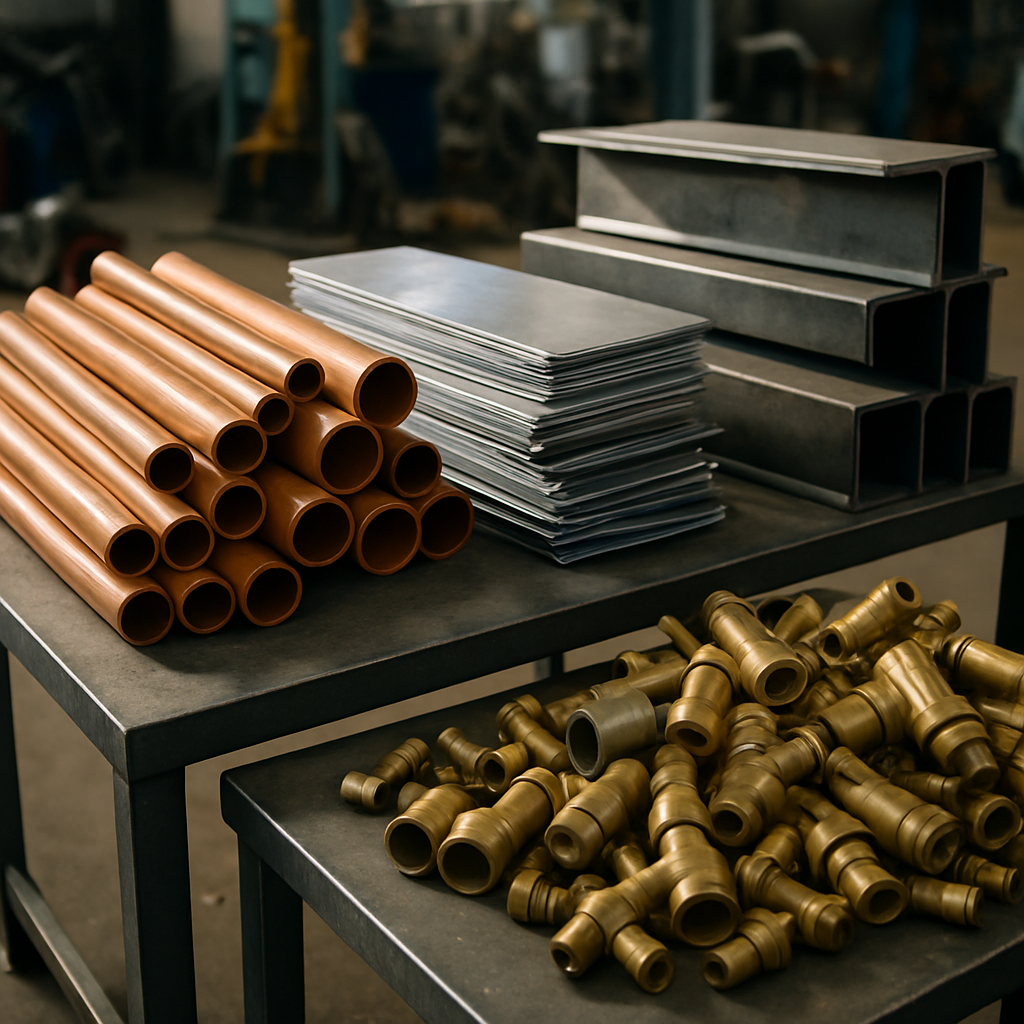5901 Botham Jean Blvd, Dallas, TX 75215
Scrap Metal Traceability: How CIM Systems Transform Recycling Operations
November 7, 2025The scrap metal traceability process establishes a digital footprint that tracks scrap materials from collection to final manufacturing. It involves systematically documenting and monitoring each piece of scrap metal throughout its recycling journey. Using computer integrated manufacturing (CIM) systems, recyclers can track material flow, weight, composition, and quality at each stage of processing.
Think of it as a passport for your scrap metal. When a load of aluminum scrap arrives at a recycling facility, the traceability system records its origin, weight, grade, and other critical details. This information remains linked to the material as it moves through sorting, shredding, and melting, eventually becoming part of a new product. The system captures data on both the finished materials and any byproducts created during processing.
Traceability is essential in modern recycling operations. It helps facilities maintain quality control, meet regulatory requirements, and optimize processes. For example, when a construction company delivers steel beams for recycling, the traceability system ensures the material is properly categorized, efficiently processed, and its value accurately calculated. This transparency benefits everyone in the recycling chain, from scrap collectors to manufacturers using recycled materials.
How Does CIM Enable Scrap Metal Traceability?

An organized display of various scrap metals, showcasing copper pipes, aluminum sheets, steel beams, and brass fittings under good lighting.
Computer integrated manufacturing (CIM) systems enhance scrap metal tracking by creating a comprehensive digital record of each material piece moving through production. The XL200 machine controller exemplifies this technology’s precision, monitoring every millimeter of material that passes through processing equipment.
These advanced systems convert what was once considered waste into valuable data points. When properly configured, the controller maintains detailed records of all metal processed—both quality parts and scrap. This provides unprecedented visibility into material usage patterns and waste generation.
Real-Time Data Collection
The foundation of effective scrap traceability lies in real-time data collection. CIM systems continuously track and record vital information about material flow:
- Exact measurements of material consumption for each operation
- Quantity and dimensions of good parts produced
- Volume and weight of scrap generated
- Timestamp information for each production event
- Machine and operator identifiers linked to specific jobs
This detailed data collection eliminates guesswork about scrap origins. When significant scrap is created, the XL200 controller prompts operators to indicate the specific reason for material loss, categorizing it appropriately for later analysis.
Standardized Reason Codes
To keep tracking manageable, most operations maintain a focused list of scrap reason codes—typically between 5-25 depending on the facility’s complexity. The XL200 can accommodate up to 99 different reason codes, providing flexibility for detailed categorization while maintaining operational efficiency.
These standardized codes transform random scrap events into structured data. Common reason groupings include:
- Engineered scrap (such as necessary shear kerf)
- Changeover waste from switching materials
- Vendor-related defects in incoming materials
- Operator-induced errors
- Maintenance-related issues
Correlation Analysis
The true power of CIM-based traceability emerges through correlation analysis. With comprehensive data capture, recycling operations can identify patterns and relationships between scrap generation and various operational factors:
A manufacturer might find that a particular machine consistently produces higher scrap rates during certain shifts, or that specific material vendors are associated with quality issues. The system can also track scrap against different products, revealing which designs create more waste.
Benefits for Recycling Operations
For recycling businesses, this traceability creates numerous advantages. It ensures every piece of metal is accounted for, supporting accurate pricing and compliance requirements. It also provides essential data for continuous improvement programs aimed at reducing material waste.
The detailed tracking enables more precise forecasting of scrap volumes, helping recyclers optimize their processes and resource allocation. By understanding exactly where and why scrap is generated, facilities can implement targeted improvements that significantly reduce waste over time.
This data-driven approach transforms scrap from an inevitable byproduct into a managed resource that can be systematically reduced through process improvements, ultimately increasing profitability while supporting sustainability goals.
What Are Common Reasons for Scrap Generation?
Within the metals industry, generating scrap is an inevitable part of transforming raw materials into finished products. While some scrap is unavoidable, excessive waste increases production costs and decreases profitability. Recognizing the sources of scrap is essential for implementing effective waste reduction strategies.
Metal processors encounter several common categories of scrap generation throughout their operations. Each type presents unique challenges but also offers opportunities for process improvement and waste reduction. Proper tracking and analysis of these scrap sources can lead to significant cost savings and more sustainable operations.
Types of Scrap Generation in Metal Processing
Here are the primary reasons for scrap generation during metal processing operations:
- Engineered Scrap – This planned, unavoidable waste arises by design during regular production processes. Examples include shear kerf (material lost during cutting operations), edge trim from coil processing, and end cuts from extrusion processes. While engineered scrap can’t be completely eliminated, optimized nesting software and cutting layouts can minimize its volume.
- Changeover Scrap – Generated when transitioning between different product runs or material types. During these adjustments, material processed often fails to meet quality standards. For example, a steel service center switching from processing 16-gauge to 20-gauge material might produce several feet of off-spec material until machine settings stabilize.
- Vendor-Related Issues – Scrap resulting from defects in incoming raw materials, such as thickness variations, surface defects, or chemical composition inconsistencies, often isn’t detected until processing begins, leading to rejected material that must be scrapped.
- Operator-Induced Scrap – Waste created through human error or improper machine operation, such as incorrect machine setup, misreading specifications, or material handling mistakes. For instance, an operator might input incorrect dimensions into a cutting machine, resulting in a batch of unusable parts.
- Unplanned Maintenance Scrap – Material wasted due to equipment malfunctions or breakdowns during production. When a machine stops mid-process, the material being worked on often cannot be salvaged. A sudden die failure in a stamping operation could damage material in process, requiring it to be scrapped.
Advanced production monitoring systems like the XL200 enable metal processors to track scrap generation precisely. These systems can be customized to include specific scrap reason categories pertinent to an operation. When significant scrap is generated, operators are prompted to input the reason, creating a database for detailed tracking and analysis.
By systematically analyzing scrap reasons, metal processing operations can identify patterns and implement targeted improvements. For example, if data shows consistently high changeover scrap for certain product transitions, procedures might be developed to optimize those transitions. Similarly, if vendor-related issues from a particular supplier cause excessive scrap, this data provides leverage for quality discussions or sourcing decisions.
Comprehensive scrap tracking not only reduces waste but also enhances operational efficiency. Understanding where and why scrap is generated allows teams to develop more effective processes and make better-informed decisions regarding equipment maintenance, operator training, and vendor management.
How is Scrap Data Analyzed and Reported?

The XL200 controller meticulously tracks every millimeter of material that moves through roll forming equipment. This data forms the foundation for comprehensive scrap analysis using the Eclipse Production Management Software. The system converts raw data into actionable intelligence through structured reporting.
Eclipse Production Management Software offers four key report types that provide valuable insights into scrap generation, each serving a specific purpose in understanding and addressing waste in manufacturing processes.
Production Summary Reports
Production Summary reports deliver an overview of manufacturing operations over specified timeframes. These reports include total good production, measured in both length and weight, total scrap produced, scrap percentage, and reclaimed scrap figures. They also track operational metrics like the number of coil, material, and tooling changes, as well as run time percentages and average running speeds.
This comprehensive view helps managers quickly identify shifts or machines with unusual scrap levels. Production teams can prioritize improvement efforts where they will have the greatest impact.
Scrap Summary Reports
Scrap Summary reports break down waste by cause, enabling Pareto analysis of scrap generation. These reports organize scrap reasons in descending order by percentage, making it clear which issues create the most waste. For each scrap reason, the report details total length, percentage by length, weight, percentage by weight, average length per occurrence, and total occurrences.
The ability to filter these reports by machine, machine group, shift, operator, date, material type, thickness, or product code helps identify correlations between these factors and scrap generation. This analysis is crucial for targeted improvement initiatives.
Coil Summary Reports
Coil Summary reports track scrap at the individual coil level, providing detailed breakdowns of scrap reasons for each coil. This data allows quality comparisons between material suppliers. Manufacturers can use this information to evaluate vendor performance and make informed purchasing decisions.
When a specific coil shows unusually high scrap rates, the detailed breakdown indicates whether the issue stems from material defects or process problems, preventing misattribution of blame between suppliers and internal processes.
Operating Efficiency (OEE) Reports
OEE reports measure Overall Equipment Effectiveness by analyzing availability percentage (run time/available production time), speed percentage (actual speed/target speed), and yield percentage (good production/total production). The yield factor is directly related to scrap rates, calculated as 100% minus the scrap percentage.
These reports help management understand how scrap impacts overall efficiency metrics. Addressing scrap issues can significantly improve OEE scores, leading to better capacity utilization.
Data-Driven Decision Making
Eclipse’s robust reporting capabilities transform raw production data into strategic intelligence. Companies use these reports to:
- Determine actual product profitability by accounting for true material costs
- Support targeted continuous improvement projects focused on scrap reduction
- Evaluate material vendors’ performance objectively
- Justify capital equipment investments based on potential scrap reduction
- Identify training opportunities for operators with higher scrap rates
- Direct maintenance efforts to equipment causing quality issues
When scrap data reveals patterns, manufacturers can implement specific corrective actions. For example, a metal building component manufacturer discovered through Scrap Summary reports that operator-induced errors were causing 32% of their total scrap. They implemented targeted training programs, reducing this category by 75% within three months.
The combination of detailed data collection at the machine level and sophisticated analysis through Eclipse Production Management Software is a powerful tool for waste reduction and operational excellence.
Conclusion: Turning Scrap Data into Measurable Profit
The scrap metal traceability process fundamentally transforms recycling from a simple material-handling operation into a data-driven, high-efficiency business. By leveraging Computer Integrated Manufacturing (CIM) systems, operators move beyond just tracking scrap to truly understanding it.
The power lies in analyzing standardized reason codes and detailed reports on production, coils, and OEE. This data-driven approach provides the actionable intelligence needed to reduce waste, optimize vendor quality, and improve operator training. Ultimately, traceability turns an inevitable byproduct into a managed resource, directly boosting profitability and driving continuous improvement.
For a recycling partner that leverages technology and transparency to maximize the value of your materials, reach out to our team. Contact Okon Recycling at 214-717-4083 to discuss your metal recycling needs.
